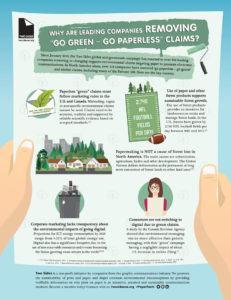by Phil Riebel, President
Two Sides North America, Inc.
Communicating the true facts about the use of print and paper continues to be a struggle with certain companies and entities spreading untruths about its sustainability. Two Sides North America, Inc. is on the forefront of tackling the relevant environmental and social issues head-on with factual, authoritative information that exposes the myths, explains the sustainable features of print and paper and gives stakeholders a solid foundation for making well-informed decisions about the use of print and paper.
Here, Two Sides North America provides an overview of facts and studies on sustainability as the organization advocates to keep the printing and graphic arts industry informed.
Changing perceptions by challenging “greenwashing”
A primary initiative of Two Sides North America is to challenge corporations when they are making misleading environmental claims about print and paper.
Two Sides North America has released a new infographic that illustrates why 118 North American companies and more than 360 companies globally have removed ‘go green – go paperless’ and similar environmental claims. The arguments for why companies are changing their messaging include:
- Paperless ‘green’ claims must follow marketing rules in the US and Canada. Claims need to be accurate, truthful and supported by reliable scientific evidence based on accepted standards.
- Papermaking is not a cause of forest loss in North America. The main causes are urbanization, agriculture, hydro power projects and other developments.
- Corporate marketing lacks transparency about the environmental impacts of going digital. Electronic communications have a significant and growing environmental footprint and use non-renewable raw materials for manufacturing.
- Consumers are not switching to digital due to green claims. Paper still is preferred by many, and a recent study has shown that paperless green claims do not convince consumers to switch to online services.
Paper and packaging have a positive story to tell
Paper producers and the forestry industry, in general, have been battling the perception that using paper and packaging products is bad for the environment. While there always is room for improvement, the paper industry has concentrated efforts on responsible forestry management, recycling and reducing energy use and greenhouse gas emissions.
One way Two Sides North America shares these messages is by showing how the paper and packaging industry is part of a circular economy where the renewability of raw materials, use of renewable energy, recycling and reuse all factor into the manufacturing design.
Know where your paper comes from – sustainable forest management
In the US, we grow many more trees than we harvest. Between 2005 and 2015, US forests had a net growth of the equivalent of 2,740 NFL football fields each day – that’s a total of almost 1.3 million acres a year. In fact, there are 20% more trees today than there were on the first Earth Day Celebration in 1970.2
It turns out that the consumption of paper and other wood products, along with sustainable forest management, is essential to maintaining this growth.
Private landowners provide more than 90% of wood and paper products in the US, which is an important factor in ensuring the long-term health of US forests. When receiving income for wood products grown on their land, family forest owners and other private land owners are incentivized to engage in smart, sustainable harvesting practices. Moreover, profitable forest management may prevent the conversion of land to non-forest uses like real estate development and agriculture.
Recycled paper and fresh wood are essential to the paper life cycle
In North America, paper is recycled more than any other commodity. The American Forest and Paper Association just announced that the paper recovery rate just hit a high of 68.1%, with a goal to reach 70% by 2020.4 Canada has one of the highest paper recovery rates in the world at 73%. Recycling is a key aspect of this circular economy – treating all materials, including by-products, as valuable resources rather than wastes. About 39% of the fiber used in papermaking in the US is obtained through recycling.
While collecting and recycling paper is good for the environment, wood fibers in recycled materials eventually become weak and break down after a maximum of five to seven times of use. Without fresh wood, recycled fiber quickly would run out and paper production rapidly would cease. As such, a continuous supply of fresh wood fiber harvested from responsibly managed forests is vital for keeping the paper life cycle going.
The carbon footprint of paper is lower than you think

A look across the life cycle of paper shows that its carbon footprint can be divided into three basic elements: greenhouse gas emissions, carbon sequestration and avoided emissions. Each of these elements make paper’s carbon footprint smaller than might be expected: it’s made from a renewable resource that stores carbon, it’s manufactured using mostly renewable energy and it’s recyclable.
One of the great advantages of papermaking is that the manufacturing process uses a large percentage of renewable energy in the form of carbon-neutral biomass (wood waste from sustainably managed forests). Roughly two-thirds of the energy used by North American pulp and paper mills is self-generated using renewable, carbon-neutral biomass in combined heat and power (CHP) systems.
In a 2018 US consumer survey, 91% of respondents believed that when responsibly produced, used and recycled, print and paper can be a sustainable way to communicate.
Preferences for paper in a digital world
Paper plays a significant role in our cultural development – contributing to education, literacy, security and personal preference to receive information on paper vs. digitally. Between 2015 and 2018, Two Sides North America partnered with global polling firm Toluna to conduct consumer surveys on how Americans feel about print and paper. Results include the following:
- 88% believe they understand, retain or use information better when they read print
- 62% of 18 to 24-year-olds have concerns that the overuse of electronic devices could be damaging to their health
- 73% of Americans feel that reading a printed book or magazine is more enjoyable than reading them on an electronic device
Two Sides North America will continue to bust myths about the print, paper and packaging industry through facts, research and data. Find resources and materials on the website at www.twosidesna.org, including infographics, fact sheets and marketing tools, or learn about becoming a member.
Two Sides North America is an independent, nonprofit organization created to promote the responsible production and sustainability of print and paper. Two Sides is active globally in North America, Europe, Australia, South Africa and Brazil. Our members span the entire print and paper value chain, including forestry, pulp, paper, inks and chemicals, pre-press, press, finishing, publishing, printing, envelopes and postal operators. For more information, visit www.twosidesna.org.





